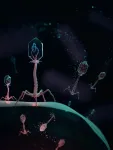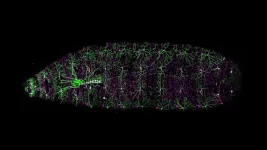(Press-News.org) Breaking a longstanding impasse in our understanding of olfaction, scientists at UC San Francisco (UCSF) have created the first molecular-level, 3D picture of how an odor molecule activates a human odorant receptor, a crucial step in deciphering the sense of smell.
The findings, appearing online March 15, 2023, in Nature, are poised to reignite interest in the science of smell with implications for fragrances, food science, and beyond. Odorant receptors - proteins that bind odor molecules on the surface of olfactory cells - make up half of the largest, most diverse family of receptors in our bodies; A deeper understanding of them paves the way for new insights about a range of biological processes.
"This has been a huge goal in the field for some time,” said Aashish Manglik, MD, PhD, an associate professor of pharmaceutical chemistry and a senior author of the study. The dream, he said, is to map the interactions of thousands of scent molecules with hundreds of odorant receptors, so that a chemist could design a molecule and predict what it would smell like.
“But we haven’t been able to make this map because, without a picture, we don’t know how odor molecules react with their corresponding odor receptors,” Manglik said.
A Picture Paints the Scent of Cheese
Smell involves about 400 unique receptors. Each of the hundreds of thousands of scents we can detect is made of a mixture of different odor molecules. Each type of molecule may be detected by an array of receptors, creating a puzzle for the brain to solve each time the nose catches a whiff of something new.
“It’s like hitting keys on a piano to produce a chord,” said Hiroaki Matsunami, PhD, professor of molecular genetics and microbiology at Duke University and a close collaborator of Manglik. Matsunami’s work over the past two decades has focused on decoding the sense of smell. “Seeing how an odorant receptor binds an odorant explains how this works at a fundamental level.”
To create that picture, Manglik’s lab used a type of imaging called cryo-electron microscopy (cryo-EM), that allows researchers to see atomic structure and study the molecular shapes of proteins. But before Manglik’s team could visualize the odorant receptor binding a scent molecule, they first needed to purify a sufficient quantity of the receptor protein.
Odorant receptors are notoriously challenging, some say impossible, to make in the lab for such purposes.
The Manglik and Matsunami teams looked for an odorant receptor that was abundant in both the body and the nose, thinking it might be easier to make artificially, and one that also could detect water-soluble odorants. They settled on a receptor called OR51E2, which is known to respond to propionate – a molecule that contributes to the pungent smell of Swiss cheese.
But even OR51E2 proved hard to make in the lab. Typical cryo-EM experiments require a milligram of protein to produce atomic-level images, but co-first author Christian Billesbøelle, PhD, a senior scientist in the Manglik Lab, developed approaches to use only 1/100th of a milligram of OR51E2, putting the snapshot of receptor and odorant within reach.
"We made this happen by overcoming several technical impasses that have stifled the field for a long time,” said Billesbøelle. “Doing that allowed us to catch the first glimpse of an odorant connecting with a human odorant receptor at the very moment a scent is detected.”
This molecular snapshot showed that propionate sticks tightly to OR51E2 thanks to a very specific fit between odorant and receptor. The finding jibes with one of the duties of the olfactory system as a sentinel for danger.
While propionate contributes to the rich, nutty aroma of Swiss cheese, on its own, its scent is much less appetizing.
“This receptor is laser focused on trying to sense propionate and may have evolved to help detect when food has gone bad,” said Manglik. Receptors for pleasing smells like menthol or caraway might instead interact more loosely with odorants, he speculated.
Just a Whiff
Along with employing a large number of receptors at a time, another interesting quality of the sense of smell is our ability to detect tiny amounts of odors that can come and go. To investigate how propionate activates this receptor, the collaboration enlisted quantitative biologist Nagarajan Vaidehi, PhD, at City of Hope, who used physics-based methods to simulate and make movies of how OR51E2 is turned on by propionate.
“We performed computer simulations to understand how propionate causes a shape change in the receptor at an atomic level,” said Vaidehi. “These shape changes play a critical role in how the odorant receptor initiates the cell signaling process leading to our sense of smell.”
The team is now developing more efficient techniques to study other odorant-receptor pairs, and to understand the non-olfactory biology associated with the receptors, which have been implicated in prostate cancer and serotonin release in the gut.
Manglik envisions a future where novel smells can be designed based on an understanding of how a chemical’s shape leads to a perceptual experience, not unlike how pharmaceutical chemists today design drugs based on the atomic shapes of disease-causing proteins.
“We’ve dreamed of tackling this problem for years,” he said. “We now have our first toehold, the first glimpse of how the molecules of smell bind to our odorant receptors. For us, this is just the beginning.”
Authors: Additional UCSF authors include Claudia Llinas del Torrent, Linus Li, and Bryan Faust, of the Department of Pharmaceutical Chemistry. For other authors, please see the paper.
Funding: This work was supported by NIH grants R01DC020353, K99DC018333 and the UCSF Program for Breakthrough Biomedical Research, funded in part by the Sandler Foundation. Cryo-EM equipment at UCSF is partially supported by NIH grants S10OD020054 and S10OD021741. For other funding, please see the paper.
About UCSF: The University of California, San Francisco (UCSF) is exclusively focused on the health sciences and is dedicated to promoting health worldwide through advanced biomedical research, graduate-level education in the life sciences and health professions, and excellence in patient care. UCSF Health, which serves as UCSF's primary academic medical center, includes top-ranked specialty hospitals and other clinical programs, and has affiliations throughout the Bay Area. UCSF School of Medicine also has a regional campus in Fresno. Learn more at https://ucsf.edu, or see our Fact Sheet.
###
Follow UCSF
ucsf.edu | Facebook.com/ucsf | YouTube.com/ucsf
END
Making sense of scents: Deciphering our sense of smell
First molecular images of olfaction open door to creating novel smells
2023-03-15
ELSE PRESS RELEASES FROM THIS DATE:
Scientists discover key information about the function of mitochondria in cancer cells
2023-03-15
Scientists have long known that mitochondria, the "powerhouses" of cells, play a crucial role in the metabolism and energy production of cancer cells. However, until now, little was known about the relationship between the structural organization of mitochondrial networks and their functional bioenergetic activity at the level of whole tumors.
In a new study, published in Nature, researchers from the UCLA Jonsson Comprehensive Cancer Center used positron emission tomography (PET) in combination ...
Artificial Sweetener could dampen immune response to disease in mice
2023-03-15
Francis Crick Institute press release
Under strict embargo: 16:00hrs GMT Wednesday, March 15, 2023
Peer reviewed
Experimental study
Animals / Cells
Artificial Sweetener could dampen immune response to disease in mice
Scientists at the Francis Crick Institute have found that high consumption of a common artificial sweetener, sucralose, lowers activation of T-cells, an important component of the immune system, in mice.
If found to have similar effects in humans, one day it could be used therapeutically to help dampen T-cell responses. For example, in patients with autoimmune diseases who ...
New research shows recovering tropical forests offset just one quarter of carbon emissions from new tropical deforestation and forest degradation
2023-03-15
A pioneering global study has found deforestation and forests lost or damaged due to human and environmental change, such as fire and logging, are fast outstripping current rates of forest regrowth.
Tropical forests are vital ecosystems in the fight against both climate and ecological emergencies. The research, published today in Nature and led by the University of Bristol, highlights the carbon storage potential and the current limits of forest regrowth to addressing such crises.
The findings showed degraded forests recovering from human disturbances, and secondary forests regrowing ...
Targeting menin induces responses in acute leukemias with KMT2A rearrangements or NPM1 mutations
2023-03-15
Researchers from The University of Texas MD Anderson Cancer Center showed that inhibiting menin with revumenib, previously known as SNDX-5613, yielded encouraging responses for advanced acute leukemias with KMT2A rearrangements or mutant NPM1. Findings from the Phase I AUGMENT-101 trial were published today in Nature.
The overall response rate among 60 patients was 53%, and the rate of complete remission or complete remission with partial hematologic recovery was 30%, with 78% of patients achieving clearance of measurable residual disease. Responses were seen across multiple dose ...
Bird flu associated with hundreds of seal deaths in New England in 2022, Tufts researchers find
2023-03-15
Researchers at Cummings School of Veterinary Medicine at Tufts University found that an outbreak of highly pathogenic avian influenza (HPAI) was associated with the deaths of more than 330 New England harbor and gray seals along the North Atlantic coast in June and July 2022, and the outbreak was connected to a wave of avian influenza in birds in the region.
The study was published on March 15 in the journal Emerging Infectious Disease.
HPAI is more commonly known as bird flu, and the H5N1 strain has been responsible for about 60 million poultry ...
Designing more useful bacteria
2023-03-15
In a step forward for genetic engineering and synthetic biology, researchers have modified a strain of Escherichia coli bacteria to be immune to natural viral infections while also minimizing the potential for the bacteria or their modified genes to escape into the wild.
The work promises to reduce the threats of viral contamination when harnessing bacteria to produce medicines such as insulin as well as other useful substances, such as biofuels. Currently, viruses that infect vats of bacteria can halt production, compromise ...
New laser technology developed by EPFL and IBM
2023-03-15
Scientists at EPFL and IBM have developed a new type of laser that could have a significant impact on optical ranging technology. The laser is based on a material called lithium niobate, often used in the field of optical modulators, which controls the frequency or intensity of light that is transmitted through a device.
Lithium niobate is particularly useful because it can handle a lot of optical power and has a high “Pockels coefficient”, which means that it can change its optical properties when an electric field is applied to it.
The researchers achieved their breakthrough by combining ...
How genome doubling helps cancer develop
2023-03-15
A single cell contains 2-3 meters of DNA, meaning that the only way to store it is to package it into tight coils. The solution is chromatin: a complex of DNA wrapped around proteins called histones. In the 3D space, this complex is progressively folded into a multi-layered organization composed of loops, domains, and compartments, which makes up what we know as chromosomes. The organization of chromatin is closely linked to gene expression and the cell’s proper function, so any problems in chromatin structure can have detrimental effects, including the development of cancer.
A common event in around 30% of all human cancers is “whole genome doubling” ...
Magnificent wiring
2023-03-15
NEW YORK – For a functioning brain to develop from its embryonic beginnings, so much has to happen and go exactly right with exquisite precision, according to a just-so sequence in space and time. It’s like starting with a brick that somehow replicates and differentiates into a hundred types of building materials that also replicate, while simultaneously self-assembling into a handsome skyscraper replete with functioning thermal, plumbing, security and electrical systems.
The accompanying microscope image, from ...
Self-driven laboratory, AlphaFlow, speeds chemical discovery
2023-03-15
A team of chemical engineering researchers has developed a self-driven lab that is capable of identifying and optimizing new complex multistep reaction routes for the synthesis of advanced functional materials and molecules. In a proof-of-concept demonstration, the system found a more efficient way to produce high-quality semiconductor nanocrystals that are used in optical and photonic devices.
“Progress in materials and molecular discovery is slow, because conventional techniques for discovering new chemistries rely on varying ...
LAST 30 PRESS RELEASES:
Shingles vaccine linked to slower biological aging in older adults
A self-assembling shortcut to better organic solar cells
A two-week leap in breeding: Antarctic penguins’ striking climate adaptation
Climate risks to insurance and reinsurance of global supply chains
58% of patients affected by 2022 mpox outbreak report lasting physical symptoms
Golden Gate method enables rapid, fully-synthetic engineering of therapeutically relevant bacteriophages
Polar weather on Jupiter and Saturn hints at the planets’ interior details
Socio-environmental movements: key global guardians of biodiversity amid rising violence
Global warming and CO2 emissions 56 million years ago resulted in massive forest fires and soil erosion
Hidden order in quantum chaos: the pseudogap
Exploring why adapting to the environment is more difficult as people age
Society for Laboratory Automation and Screening welcomes new scientific director: Madeline M. Farley, Ph.D.
Austrian cow shows first case of flexible, multi-purpose tool use in cattle
Human nasal passages defend against the common cold and help determine how sick we get
Research alert: Spreading drug costs over the year may ease financial burden for Medicare cancer patients
Hospital partnership improves follow up scans, decreases long term risk after aortic repair
Layered hydrogen silicane for safe, lightweight, and energy-efficient hydrogen carrier
Observing positronium beam as a quantum matter wave for the first time
IEEE study investigates the effects of pointing error on quantum key distribution systems
Analyzing submerged fault structures to predict future earthquakes in Türkiye
Quantum ‘alchemy’ made feasible with excitons
‘Revoice’ device gives stroke patients their voice back
USF-led study: AI helps reveal global surge in floating algae
New method predicts asthma attacks up to five years in advance
Researchers publish first ever structural engineering manual for bamboo
National poll: Less than half of parents say swearing is never OK for kids
Decades of suffering: Long-term mental health outcomes of Kurdish chemical gas attacks
Interactional dynamics of self-assessment and advice in peer reflection on microteaching
When aging affects the young: Revealing the weight of caregiving on teenagers
Can Canada’s health systems handle increased demand during FIFA World Cup?
[Press-News.org] Making sense of scents: Deciphering our sense of smellFirst molecular images of olfaction open door to creating novel smells




